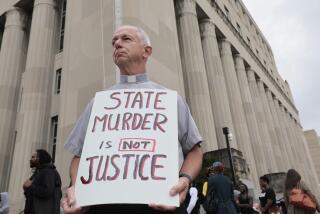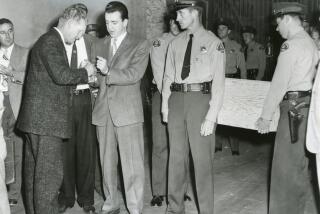Effects of Chessman’s Execution in 1960 Live On
To his final gasp in the gas chamber at San Quentin, Caryl Chessman never stopped insisting that he was not the “red light rapist” who had terrorized Los Angeles for months.
Chessman, a self-described “grinning, brooding young criminal psychopath” at the time of his arrest, had transformed himself into a best-selling author and media celebrity during 12 years on death row.
He portrayed himself as the innocent victim of a barbaric system of death penalty justice that discriminated against the poor and uneducated. He claimed that police had denied him an attorney and beaten him into making incriminating statements.
The Chessman case became a rallying cry for opponents of capital punishment, galvanizing them into a more organized movement that would gain considerable political clout. Unofficial moratoriums on the death penalty followed in California and elsewhere in the 1960s; then came the 1972 decision by the U.S. Supreme Court to strike down the death penalty, which would be reinstated four years later.
“Chessman became real to people in a way most condemned men do not,” said noted ACLU attorney Ephraim Margolin. “The result was a widespread revulsion at the idea of the state putting to death someone who had not been convicted of murder.”
Chessman was convicted of 17 felonies committed during a 1948 robbery-and-rape spree in which he allegedly tricked couples parked in “lovers’ lanes” in the Malibu Colony, near the Rose Bowl and above Mulholland Drive into thinking he was a police officer by shining a red spotlight into their cars. Two women were dragged away and forced to perform oral sex.
Chessman was sentenced to death not for the sex crimes but for kidnapping, under a law passed after the Lindbergh kidnapping that allowed the death penalty even in cases where the victim was not killed. Such laws in several states later were invalidated by the courts.
Penniless but articulate, Chessman represented himself at his trial. The judge denied him daily transcripts. A full record of the trial was never made--the court reporter died before a copy was made.
In prison, Chessman studied law, read voraciously and wrote four books. His book “Cell 2455, Death Row” sold 500,000 copies. He received eight stays of execution.
Eleanor Roosevelt, Norman Mailer, Hollywood celebrities, European intellectuals and others pleaded for Chessman’s life. Many cited Chessman as proof that even hardened criminals could be rehabilitated.
More than any other case, the Chessman case made capital punishment a divisive and emotional political issue in California and assisted the careers of pro-death penalty politicians, including Ronald Reagan, said death penalty scholar Gerald F. Uelmen, law professor at Santa Clara University.
“For people who didn’t live through it, it’s hard to imagine the enormous impact of the Chessman case,” Uelmen said. “In some ways, we’re still living with the Chessman impact: the use of the death penalty by politicians and the deep feelings by opposing sides.”
*
Gov. Pat Brown opposed the Chessman execution because he did not feel his crimes warranted execution. But Brown was powerless to stop it.
Both sides in the dispute were angry at Brown for what they saw as his indecisiveness. He blamed his 1966 loss to Reagan in part on the Chessman case.
In eight years as governor, Brown allowed 36 executions and commuted the sentences of 23 death row inmates. The governor’s 21-year-old son, Jerry, a former seminarian and future governor, begged him to grant Chessman a 60-day stay of execution, which he did.
Because Chessman had a prior felony conviction, the law of the day prohibited Brown from commuting his sentence without concurrence of the California Supreme Court. At his son’s urging, Brown tried another strategy: asking the Legislature to impose a moratorium on executions.
The Legislature, after rancorous debate, rejected the governor’s request for a moratorium. And two hours before the scheduled execution, the state high court voted 4 to 3 to reject Chessman’s appeal.
A thousand protesters waited outside San Quentin. Vigils were held in numerous cities. Crowds picketed U.S. embassies.
Shortly after 10 a.m. on May 2, 1960, Chessman was strapped into the gas chamber seat and cyanide pellets were dropped into a bucket of sulfuric acid. Chessman, 38, gasped seven or eight times, lost consciousness and was pronounced dead.
A federal judge had tried to issue a stay so that more legal arguments could be heard. His secretary dialed the wrong number. By the time the right number was reached, it was too late.
More to Read
Sign up for Essential California
The most important California stories and recommendations in your inbox every morning.
You may occasionally receive promotional content from the Los Angeles Times.










